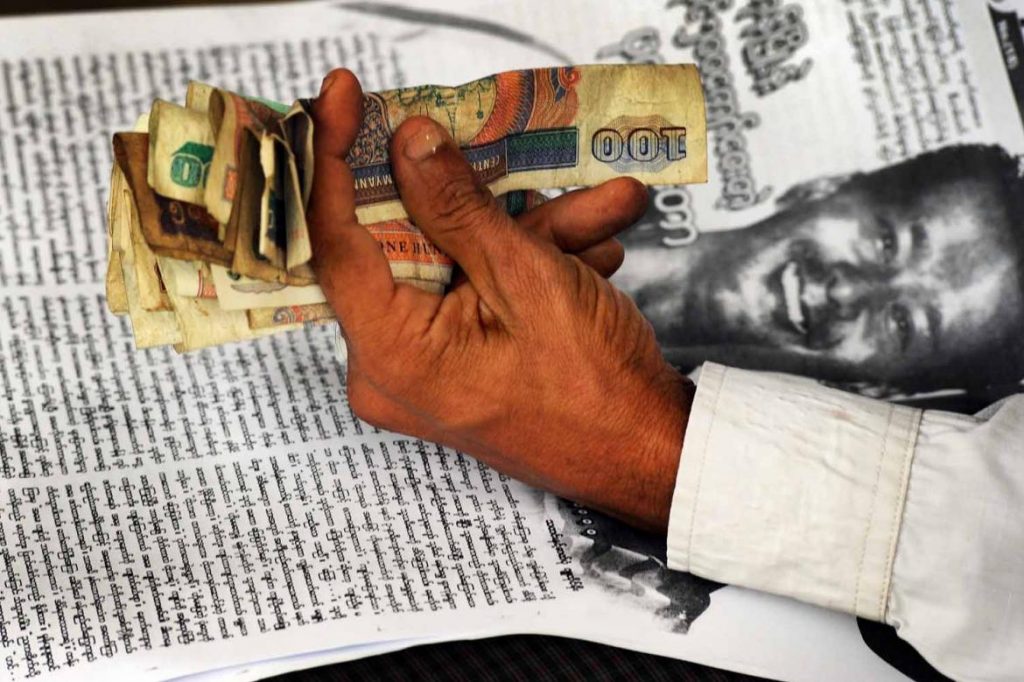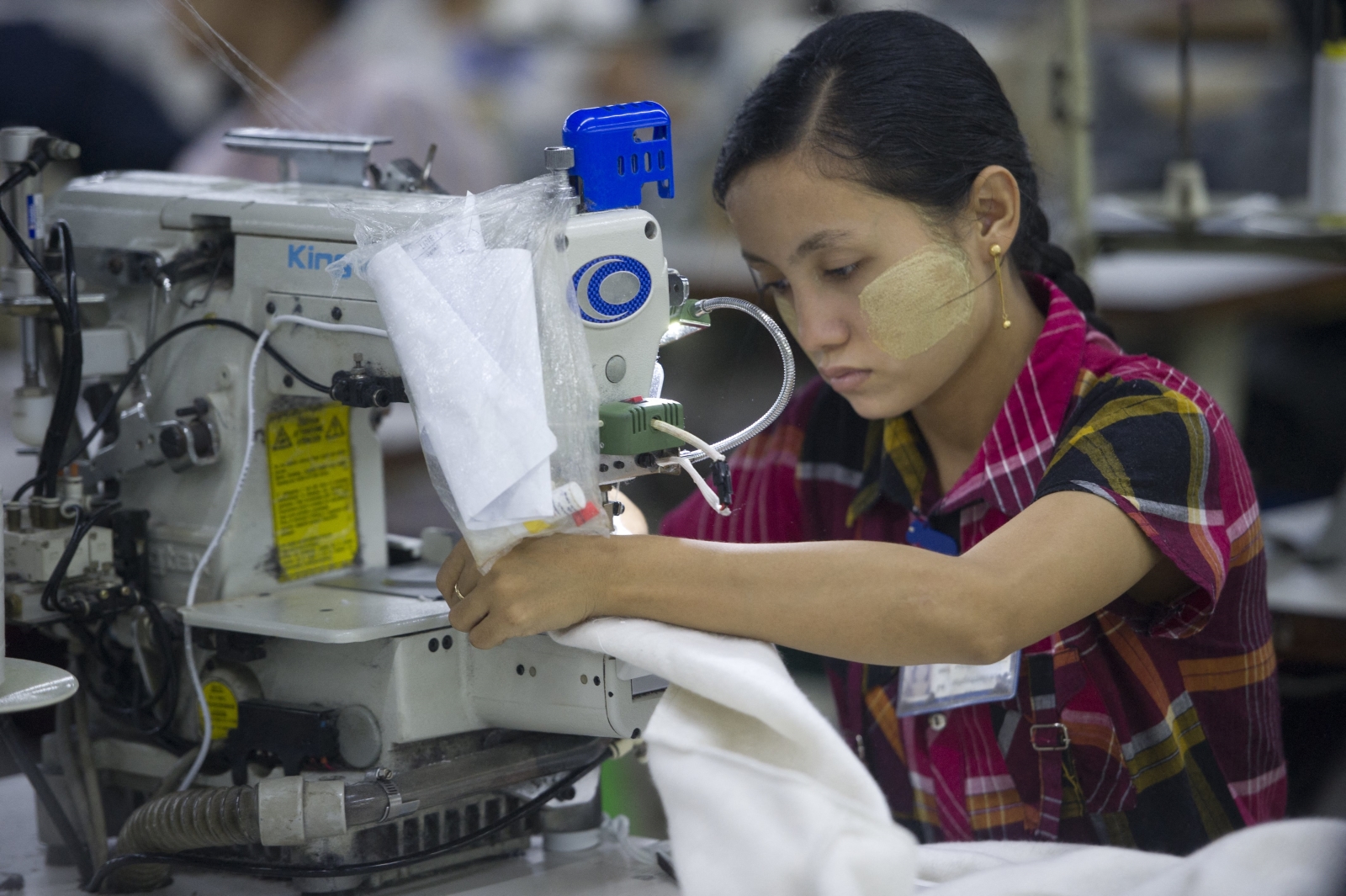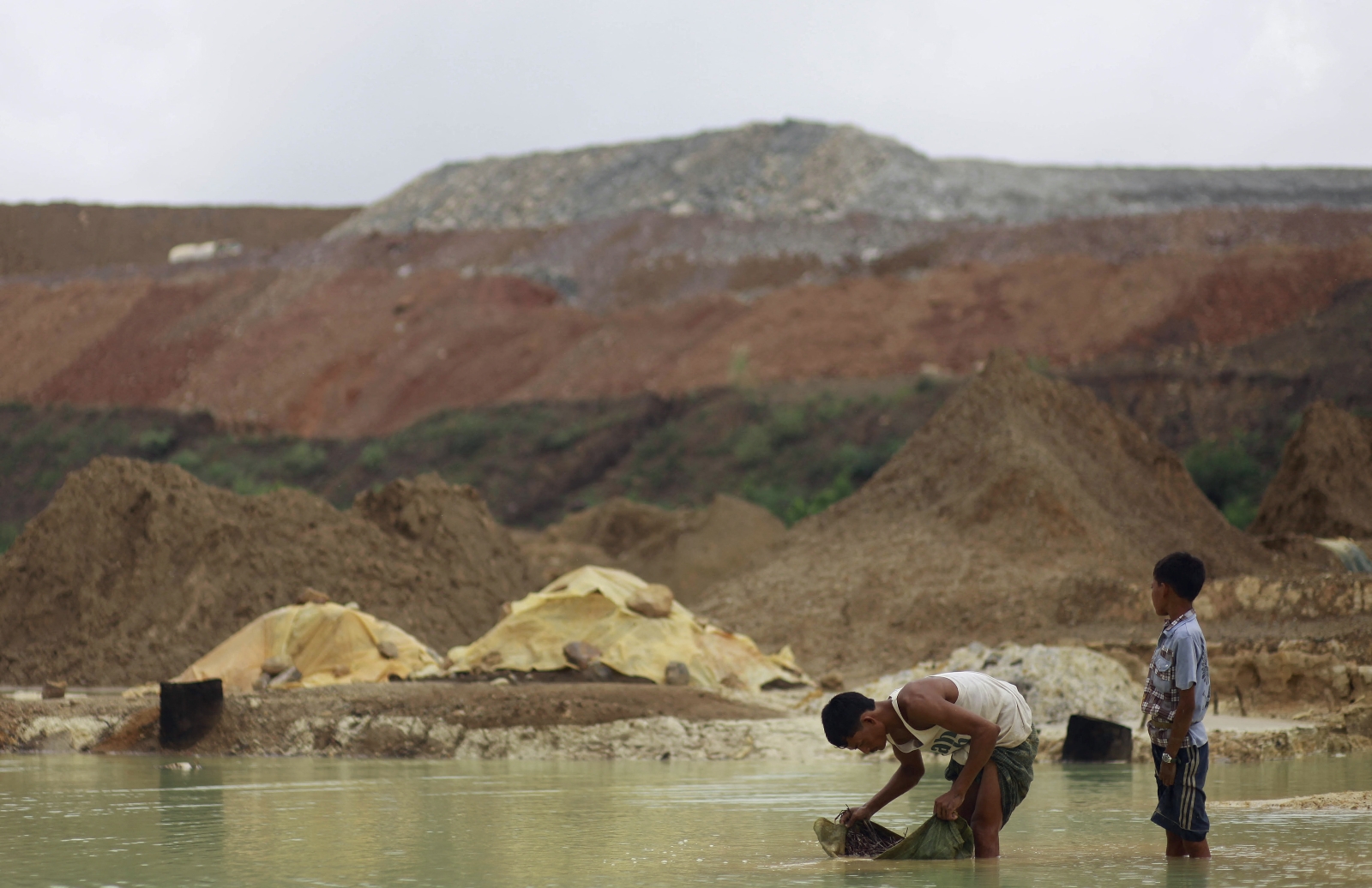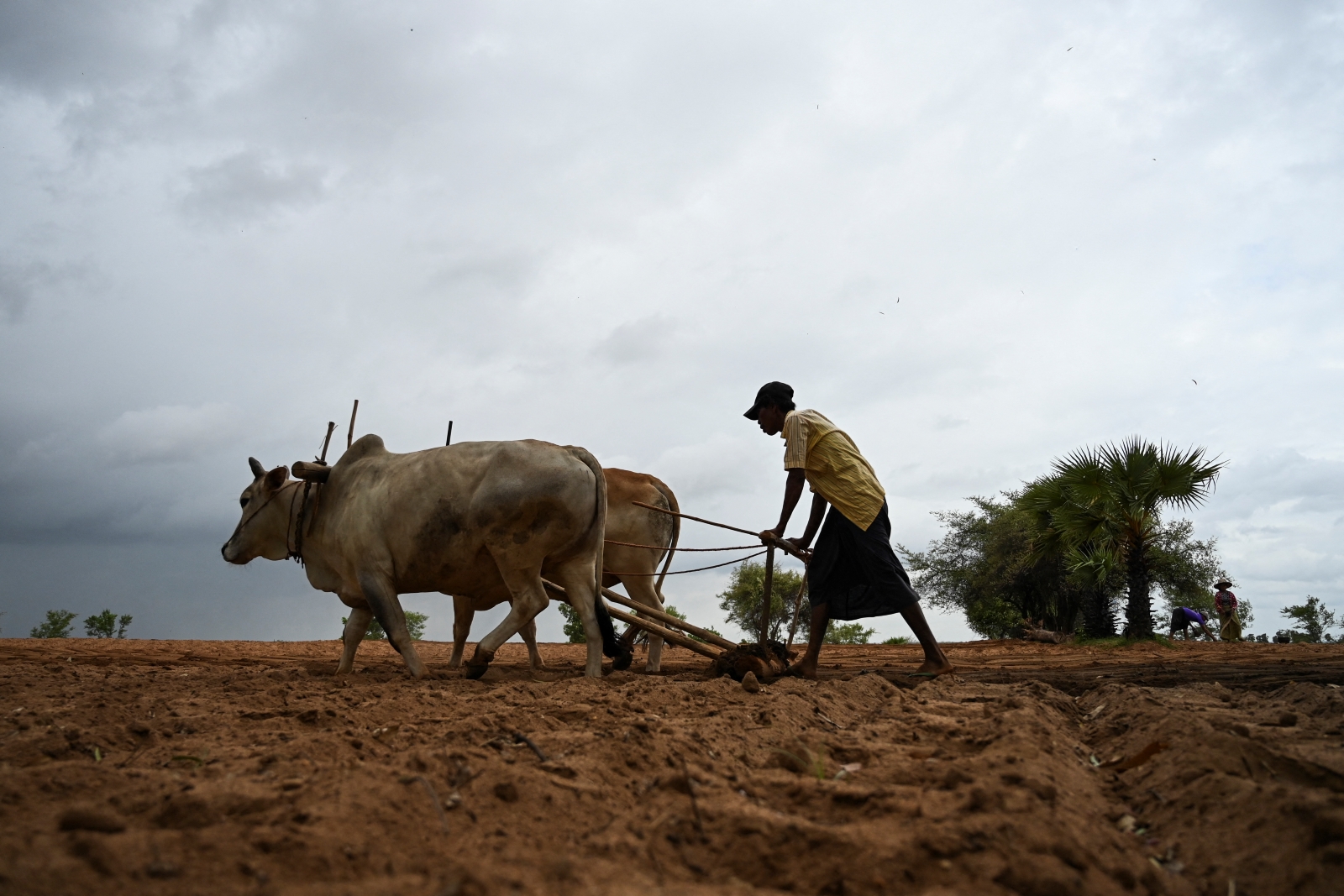Obsessing with the exchange rate and imposing bureaucratic measures will only stall reforms.
By MIN THU MAUNG | FRONTIER
THE RECENT volatility of the kyat – particularly its rapid decline in value in late 2016 – has prompted many to call for measures to manage the situation. Despite the widespread concerns about the health of the currency, the situation is not as critical as one might believe.
The trajectory of the kyat relative to the US dollar over the past three years is similar to many foreign currencies. Consider the value of the Canadian dollar and Australian dollar over the same period against the US dollar.
kyat-aud-cad-exchange-rate.jpg
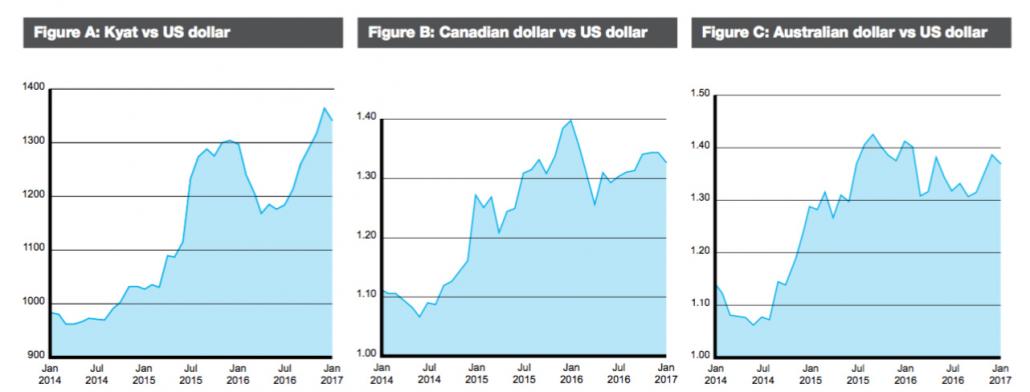
Although Australia and Canada possess advanced economies, the resemblance is remarkable. Their exchange rates vis-à-vis the dollar show very similar patterns to that of the kyat – the volatilities of the three rates are in fact almost identical.
Support more independent journalism like this. Sign up to be a Frontier member.
The Australian and Canadian economies are both highly dependent on the export of commodities, and commodity prices have significantly declined over this period. Allowing their currencies to depreciate is a coping mechanism to maintain exports and retain employment.
Myanmar also relies heavily on exports, especially natural gas. With the declining revenue from exports and rising imports – not to mention the accompanying high inflation – depreciation (and the accompanying volatility) of the kyat is only natural.
Experience shows that currency values almost inevitably decline when faced with adverse macroeconomic conditions. In particular, current account and budget deficits almost always lead to currency depreciation/devaluation unless they are offset by other financial inflows.
For instance, Laos and Cambodia ran huge deficits for several years during the past decade but inflows from foreign direct investment and financial accounts provided them with the resources to relieve pressure on their local currencies.
The first line of defence against currency depreciation is to buy up the local currency with foreign exchange reserves. During the Asian Financial Crisis of 1997, Thailand reportedly spent US$5 billion to defend its currency. Then came the second mechanism: raising the interest rates. Thailand also increased its rate from 10 percent to 12.5 percent. Raising domestic currency interest rates motivates people to hold the currency and not convert it to dollars.
Nonetheless, the Thai baht still depreciated by more than 50 percent during the final six months of 1997. When a country has depleted its reserves, the next step is to gain International Monetary Fund financing. However, IMF financing usually comes with strings attached, such as requirements to reduce spending or increase interest rates, among others. And IMF financing generally only comes after a currency has already depreciated significantly.
Again, empirical evidence shows that countries usually do not succeed in defending their currencies. The only country in recent memory that has successfully defended its currency peg was Hong Kong – and that was almost two decades ago. Attempts to defend a currency generally lead to depletion of reserves, high interest rates and, in some stances, currency controls.
This is usually followed by hysterical accusations of “manipulation” and finger pointing. Despite rigorous efforts and tough talking from fiscal authorities and governments, almost all currencies that come under attack eventually depreciate.
So where does this leave Myanmar, given the recent depreciation of its currency, and how should it respond?
It does not appear to have the foreign currency reserves to intervene. Without reserves, it is hard to “manage” a managed float, because it requires the buying and selling of the dollar as needed. Myanmar’s managed float sees the Central Bank hold a daily auction, at which banks can bid to buy or sell dollars. On January 31, the banks sought to buy $1 million – but the Central Bank decided to sell just the token amount of $100.
Even if the Central Bank had reserves, should it spend these reserves to defend the currency? It depends. Even a country with sound fundamentals could see its local currency face pressure to depreciate due to temporary conditions, such as a surge in imports or spending, or unfounded speculative attacks. In this case, the answer is almost always yes.
On the other hand, pressure to depreciate may be rooted in more chronic issues. In this case, reserves should be used to smooth out unusual fluctuations and to buy the time needed to enact reforms. This is particularly the case in emerging markets, where sharp currency depreciations generally erode confidence and it’s arguably better to let a currency depreciate gradually.
Intervening in the currency markets can allow time for FDI flows to settle in, the government to reduce the budget deficit or inflation rate, or export revenue to grow. Reserves should not be used to artificially inflate the value of a currency, though.
At the same time, the country does not seem to have much appetite to raise interest rates.. Higher interest rates increase the cost of borrowing and dampen economic growth. Although Myanmar’s interest rates are seemingly already high, it should be noted that high interest rates are typical of economies combating inflation.
At one point in 1981, the interest rate in the United States stood at 20 percent and the US went into recession. Myanmar’s economy is perhaps too fragile to experience this kind of austerity. So, instead, we are hearing the usual talk of crackdowns and controls. Some recent measures include requiring citizens and companies to provide details of offshore accounts and plans to restrict the import of luxury goods.
It’s important to acknowledge that the hardship caused by the current exchange rate volatility is real. Unlike their counterparts in advanced countries, Myanmar importers – and exporters, for that matter – do not have access to the financial instruments to hedge this risk. Nonetheless, exchange rate risk is an integral part of an open economy and this risk will remain as long as Myanmar’s economy remains open to the world.
Depreciation of the kyat is a natural deterrent for imports and this market mechanism works better than selectively restricting imports or imposing controls. Import regulations and controls create bureaucracy, corruption, and cronyism: When controls are imposed, more often than not, only a selected few importers tend to benefit.
Currency depreciation, combined with appropriate import taxes, should work well to reduce excessive imports. From 2012 to 2015 the current account deficit more than doubled, from 4.0 percent in 2012 to 8.9 percent in 2015). The Asian Development Bank is forecasting the current account deficit to remain at 8.3 percent in 2016.
But how do we know that imports have been excessive? The depreciation of kyat is the best available indicator – but it’s also perhaps the best mechanism to counter this excessiveness. Cumbersome import controls, at this point, are unnecessary.
Clamping down on black markets and restrictions on overseas foreign currency accounts are temporary and superficial measures that will only treat the symptoms but not the disease itself. Black markets exist to fill voids left by official markets. In the case of the currency, as long as the official reference exchange rate does not accurately reflect the market rate, a black market will exist.
Another concern that has been raised by the central bank (and echoed by others in the industry as well) is the hoarding of the dollar, especially in offshore accounts, for speculative purposes. Offshore currency accounts reflect a lack of trust in the country’s system.
Keynes noted that people may hold cash (or, in Myanmar’s case, foreign currency cash or liquid accounts) for transaction needs, as a precaution, or for speculation. It is indeed difficult to show that those with offshore accounts speculate. Even if dollars are hoarded for speculative purposes, one should remember that this is the nature of free markets.
It is worth asking why anyone would be willing to forego a 10 percent interest rate in a kyat-denominated fixed deposit account at a Myanmar bank and hoard the money in, say, Singapore, where it will incur 1 percent interest or lower. If such a deep lack of confidence exists, perhaps it is time for some soul searching.
Admittedly, some may hoard foreign currencies offshore to evade taxes and to conceal illegal gains. However, those with such ill intentions generally do not open foreign currency accounts in places like Singapore.
There are many exotic places in the world where some of the wealthiest people could conceal their wealth without anyone ever finding out. Clamping down on ordinary citizens who might have some relatively minor amount of foreign currency in an overseas account is, at best, a wild goose chase.
At this stage of its economic growth, Myanmar does not benefit much from a strong kyat. Artificially supporting the value of kyat creates hardship for exporters at a time when the country desperately needs to increase exports. Exports, unlike imports, create jobs. A weaker kyat also makes investment in Myanmar more attractive.
You don’t have to look far to find examples of how this can work to Myanmar’s advantage. Decades of export-led growth have lifted at least 400 million Chinese out of poverty – possibly as many as 800 million. Export-led growth also led to the rise of so-called Asian Tigers: Singapore, Hong Kong, Taiwan and South Korea.
Currency depreciation will no doubt affect prices of some imported products. However, the exchange rate is merely a symptom; inflation is the actual disease. Obsessing with the exchange rate and imposing bureaucratic measures will only stall reforms.
Myanmar needs to deregulate and not regulate more. Controls and regulation just erode investor confidence. More exports, less imports, reduced deficits, lower inflation and higher investment will naturally create a stronger kyat.


